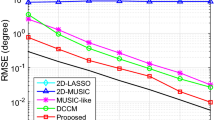Abstract
In this paper, we study the problem of four-dimensional angle estimation for bistatic multiple-input multiple-output (MIMO) radar with arbitrary arrays, and propose a close-form joint two-dimensional direction of departure and two-dimensional direction of arrival estimation algorithm. Our work is to extend the estimation of signal parameters via rotational invariance techniques (ESPRIT) algorithm to angle estimation in MIMO-radar with arbitrary arrays. The algorithm can achieve automatically paired four-dimensional angles, requires no peak searching, has low complexity, and does not need to compensate for the phase. Furthermore, the proposed algorithm has much better angle estimation performance than the interpolated ESPRIT algorithm and propagator method. We also analyze and derive the complexity of the algorithm and the Cramer–Rao bound. The simulation results verify the effectiveness of the algorithm.
Similar content being viewed by others
References
Fishler, E., Haimovich, A., Blum, R. S., Cimini, L. J., Chizhik, D., & Valenzuela, R. A. (2004, April). MIMO radar: An idea whose time has come. In Proceedings of IEEE radar Conference (pp. 71–78).
Li, J., & Stoica, P. (2006, December). MIMO radar—Diversity means superiority. In: Proceedings 14th adaptive sensor array process. Workshop (ASAP’06), Lincoln Lab, MA, USA (pp. 1–6).
Li, X., & Zhang, Z., et al. (2010). A study of frequency diversity MIMO radar beamforming. IEEE 10th international conference (ICSP2010) (pp. 352–356).
Sharma, R. (2010, June). Analysis of MIMO radar ambiguity functions and implications on clear region. IEEE radar conference (pp. 544–548).
Li, J., Liao, G., & Griffiths, H. (2011, May). Bistatic MIMO radar space-time adaptive processing. 2011 IEEE international radar conference, Westin Crown Center in Kansas City, Missouri (pp. 498–502).
Wu X. H., Kishk A. A., Glisson A. W. (2010) MIMO-OFDM radar for direction estimation. IET Radar, Sonar & Navigation 4(1): 28–36
Li J., Stoica P., Xu L., Roberts W. (2007) On parameter identifiability of MIMO radar. IEEE Signal Processing Letters 14(12): 968–971
Li, J., Liao, G., Ma, K., & Zeng, C. (2010, May). Waveform decorrelation for multitarget localization in bistatic MIMO radar systems. 2010 IEEE international radar conference, Washington, DC (pp. 21–24).
Chen J., Gu H., Su W. (2008) Angle estimation using ESPRIT without pairing in MIMO radar. Electronics Letters 44(24): 1422–1423
Yan, H., Li, J., & Liao, G. (2008). Multitarget identification and localization using bistatic MIMO radar systems. EURASIP Journal on Advances in Signal Processing, Article ID283483, 1–8.
Gao, X., Zhang, X., & Feng, G., et al. (2009). On the MUSIC-derived approaches of angle estimation for bistatic MIMO radar. International conference on wireless networks and information systems (WNIS’09) (pp. 343–346).
Chen J., Gu H., Su W. (2009) A method for fast multi-targets location in bistatic MIMO-radar system. Journal of Electronic & Information Technology 31(7): 1664–1668
Zhang X., Xu Z., Xu L., Xu D. (2011) Trilinear decomposition-based transmit angle and receive angle estimation for multiple-input multiple-output radar. IET Radar, Sonar & Navigation 5(6): 626–631
Nion D., Sidiropoulos N. D. (2009) Adaptive algorithms to track the PARAFAC decomposition of a third-order tensor. IEEE Transactions on Signal Processing 57(6): 2299–2310
Zhang X., Gao X., Feng G., Xu D. (2009) Blind joint DOA and DOD estimation and identifiability results for MIMO radar with different transmit/receive array manifolds. Progress in Electromagnetics Research B 18: 101–119
Khabbazibasmenj, A., Hassanien, A., & Vorobyov, A. S. (2011, May). Transmit beamspace design for direction finding in colocated MIMO radar with arbitrary receive array. 2011 IEEE international conference on acoustics, speech and signal processing (ICASSP) (pp. 2784–2787)
Friedlander B. (1993) The root-MUSIC algorithm for direction finding with interpolated arrays. Signal Processing 30(1): 15–19
Weiss A. J., Gavish M. (1991) Direction finding using ESPRIT with interpolated arrays. IEEE Transactions on Signal Processing 39(6): 1473–1478
Tuncer, T. E., Yasar, T. K., & Friedlander, B. (2007). DOA estimation for nonuniform linear arrays by using array interpolation. Radio science, 42(4). doi:10.1029/2007RS003641.
Stoica P., Nehorai A. (1990) Performance study of conditional and unconditional direction-of-arrival estimation. IEEE Transactions on Signal Processing 38(10): 1783–1795
Author information
Authors and Affiliations
Corresponding author
Rights and permissions
About this article
Cite this article
Li, J., Zhang, X. Closed-Form Blind 2D-DOD and 2D-DOA Estimation for MIMO Radar with Arbitrary Arrays. Wireless Pers Commun 69, 175–186 (2013). https://doi.org/10.1007/s11277-012-0567-9
Published:
Issue Date:
DOI: https://doi.org/10.1007/s11277-012-0567-9




